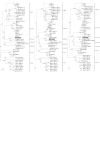Genetic relatedness of the novel human group C betacoronavirus to Tylonycteris bat coronavirus HKU4 and Pipistrellus bat coronavirus HKU5
- PMID: 26038405
- PMCID: PMC3630921
- DOI: 10.1038/emi.2012.45
Genetic relatedness of the novel human group C betacoronavirus to Tylonycteris bat coronavirus HKU4 and Pipistrellus bat coronavirus HKU5
Abstract
The recent outbreak of severe respiratory infections associated with a novel group C betacoronavirus (HCoV-EMC) from Saudi Arabia has drawn global attention to another highly probable "SARS-like" animal-to-human interspecies jumping event in coronavirus (CoV). The genome of HCoV-EMC is most closely related to Tylonycteris bat coronavirus HKU4 (Ty-BatCoV HKU4) and Pipistrellus bat coronavirus HKU5 (Pi-BatCoV HKU5) we discovered in 2006. Phylogenetically, HCoV-EMC is clustered with Ty-BatCoV HKU4/Pi-BatCoV HKU5 with high bootstrap supports, indicating that HCoV-EMC is a group C betaCoV. The major difference between HCoV-EMC and Ty-BatCoV HKU4/Pi-BatCoV HKU5 is in the region between S and E, where HCoV-EMC possesses five ORFs (NS3a-NS3e) instead of four, with low (31%-62%) amino acid identities to Ty-BatCoV HKU4/Pi-BatCoV HKU5. Comparison of the seven conserved replicase domains for species demarcation shows that HCoV-EMC is a novel CoV species. More intensive surveillance studies in bats and other animals may reveal the natural host of HCoV-EMC.
Figures


References
-
- Zaki AM, van Boheemen S, Bestebroer TM, et al. Isolation of a novel coronavirus from a man with pneumonia in Saudi Arabia N Engl J Med 2012. in press. - PubMed
-
- Woo PC, Lau SK, Lam CS, et al. Discovery of seven novel mammalian and avian coronaviruses in Deltacoronavirus supports bat coronaviruses as the gene source of Alphacoronavirus and Betacoronavirus and avian coronaviruses as the gene source of Gammacoronavirus and Deltacoronavirus. . J Virol. 2012;86:3995–4008. - PMC - PubMed
LinkOut - more resources
Full Text Sources
Other Literature Sources
Research Materials
Miscellaneous
